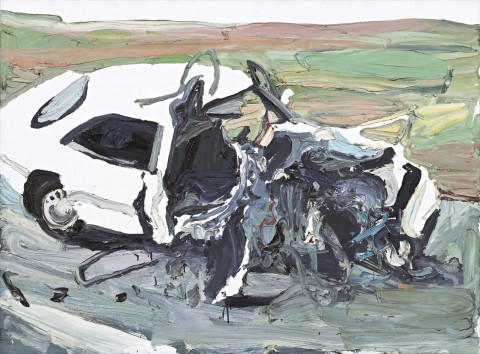CRASH PAINTING, 2010
BEN QUILTY
oil on canvas
140.0 x 190.0 cm
signed, dated and inscribed with title verso: Ben Quilty / 2010 / Crash / painting
GRANTPIRRIE, Sydney
Private collection, Sydney
Proceeds from the sale of this work will go to support the Art Gallery of New South Wales’ Sydney Modern Capital Campaign.
Within the broader context of Ben Quilty’s painting it is his images of cars which many people identify with the artist and they remain amongst his most sought-after works. Quilty arrived at his Smashed Car paintings after turning the mirror on himself and his car loving mates. The resulting images explored the adolescent males search for identity through ritual rites of passage, some of which involved driving dangerously in fast cars; recollections of youth when anything was possible, when young lads fuelled by alcohol felt they were ten-foot-tall and bulletproof.
The nuggetty Holden Torana, with its V8 engine crammed under the hood, became Quilty’s favourite car. The Torana entered Australian folklore in 1972, when Peter Brock drove it to victory against the dominant Ford Falcons at Bathurst’s annual orgy of booze and petrol on Mount Panorama. In the decades that followed the popular Torana (an Aboriginal word meaning ‘to fly’) became the choice of young men when buying their first second-hand car. By the time Quilty got his ‘P’s, the choice was easy. With Brocky’s place in the male psyche secure and John Meillon’s Victoria Bitter jingle as the sound track, Quilty and his mates took to the road in their adolescent quest for meaning and direction, all the while dangerously testing the boundaries of common sense.
The mangled appearance of Quilty’s Smashed Cars is well suited to his preference for thick oil paint amply applied. The cars become flesh-like as they rest on the road side, leaking fluids seeping from the wreckage and forming eerie shadows. The sharp contrast between the straight panels of the vehicle and the soft, smashed area goes someway to creating an image reminiscent of road kill. This juxtaposition allows the artist to contrast form with abstraction, a helpful device which amplifies the expressive qualities of the opposing approaches. Poised in a moment between the violence of the event and stillness of the aftermath, Quilty’s image hovers between order and chaos. A focal point within the violent tangle is the crimson red mark near the centre, which takes on the appearance of an exposed vein and further presses the notion of a freshly killed pulsing carcass. Crash Painting, 2010, features a distant horizon beyond a landscape devoid of trees which evokes a sense of the frontier. It is a frontier of reckless abandon where young white males test themselves against each other in deadly games of one upmanship and where testosterone overrides common sense, the deadly mix of alcohol and petrol fuelling a game of Russian roulette.
Quilty’s paintings ooze paint and metaphor. His technique of applying paint in broad, thick swathes using cake decorating tools creates a fleshy sculpted surface, which in itself echoes the youthful bravado these paintings aim to depict. Bulking up his colour with white, Quilty’s use of paint results in a soft harmonising effect that belies the artwork’s chaotic and ominous undertow and, as is his intent, takes the viewer along for the wild ride.
HENRY MULHOLLAND
